ZMINA: Rebuilding - Community Recovery After Occupation: New Beginnings in the Chernihiv Region

Interpersonal relationships, mental health, and the economy—these are just some of the areas affected by war. Improving the quality of life and rebuilding the community in the Chernihiv region is the focus of a project called Vidnova. In addition to providing support to people affected by the war, it also gives local residents the opportunity to take an active role in restoring what the conflict has destroyed. Project manager Artem Melnyk shared more details in an interview.
Could you start by telling me which specific community this project was dedicated to? Who are its members, and where is it geographically located?
The project was implemented in the Novobilouska territorial community, located in the Chernihiv region. This rural community suffered severe consequences due to the occupation and hostilities. Its residents are primarily locals, some of whom returned after the de-occupation, as well as internally displaced persons who found refuge here due to the war.
What led you to choose this particular community?
The community suffered greatly during the Russian occupation, and after the liberation it faced serious challenges in recovering, both physically and socially. We saw that this community needed support, but also had the potential to develop if provided with the necessary resources and knowledge. In addition, one of the members of our NGO is from the Chernihiv region, and this project was particularly meaningful for him, as he wanted to help his fellow countrymen who had survived the occupation.
Do you remember the initial impulse that made you start planning this project?
The main driving force was the realization that physical reconstruction was only one part of the recovery process. It was crucial not just to rebuild what had been destroyed but to actively involve local residents so they could take ownership of their community and participate in shaping its future.
How did you gather information about the community’s needs after the occupation?
Before launching the project, we conducted a survey among local residents to identify their primary needs and expectations for the reconstruction process. We also engaged with local administration, activists, and entrepreneurs to gain a deeper understanding of the situation and challenges facing the community.
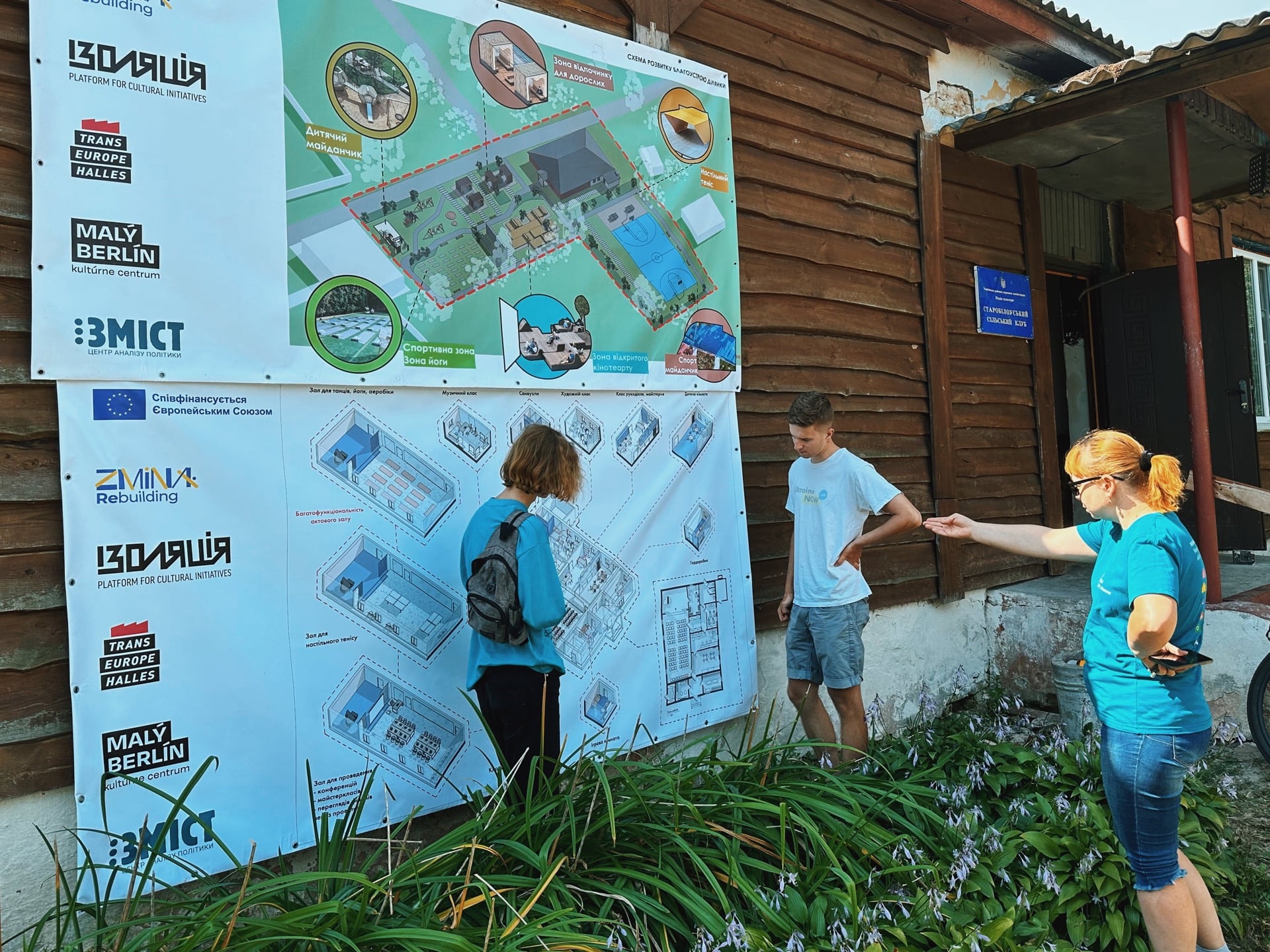
Can you explain how you defined the main goals of the project?
We focused on several key aspects: education (raising awareness among residents about reconstruction efforts), social cohesion, economic development, and environmental sustainability. These priorities were established based on the survey results and a thorough analysis of the community’s needs.
Did you take inspiration from any other projects, whether in Ukraine or abroad?
Yes, we analyzed similar initiatives both within Ukraine and internationally. However, our primary inspiration came from local projects, as we have experience working in communities and understand how crucial it is to involve local residents in the reconstruction process. Their participation in decision-making and implementing change ensures that recovery is sustainable and long-lasting. We also studied international examples, such as post-war reconstruction efforts in Poland, where public initiatives played a significant role.
What did the process of restoring physical infrastructure involve?
Our project did not focus on large-scale reconstruction but rather on creating comfortable public spaces. For instance, cost savings allowed us to enhance the area near the village club, transforming it into a more inviting and functional space for the community.
Which parts of the infrastructure required the most attention?
Public spaces where local residents could gather, communicate, and discuss the community’s future were in the greatest need of attention. The war left behind not only physical destruction but also a social vacuum—many people felt isolated, and traditional gathering places lost their functionality. That is why we prioritized improving the village club, which historically served as the cultural and social center of the community. Its surrounding area had the potential to become a welcoming public space, so we allocated our resources accordingly.
How did you plan to support economic growth in the community?
We understood that sustainable economic growth requires the active involvement of local residents. Therefore, one of our key objectives was to create conditions for self-employment and the development of small local businesses.
We focused on utilizing local resources, such as wood, which is both environmentally friendly and readily available. By organizing practical woodworking workshops, we introduced residents to innovative approaches to material use and encouraged them to explore small business opportunities.
What specific measures or activities did you implement to develop or bring new impulses to local businesses?
In addition to the sustainable woodworking workshop, we worked to raise awareness among residents about opportunities for developing their own initiatives. During our events, we held open discussions to brainstorm business ideas related to community recovery.
Did the project help create new jobs?
The project was not directly aimed at creating permanent jobs, but it provided local residents with new skills and potential avenues for income generation. For example, after attending the workshop, several participants expressed interest in further developing their woodworking skills, which could serve as a foundation for future self-employment. Another crucial aspect was the creation of a network connecting local residents, entrepreneurs, and experts, fostering opportunities for future initiatives.
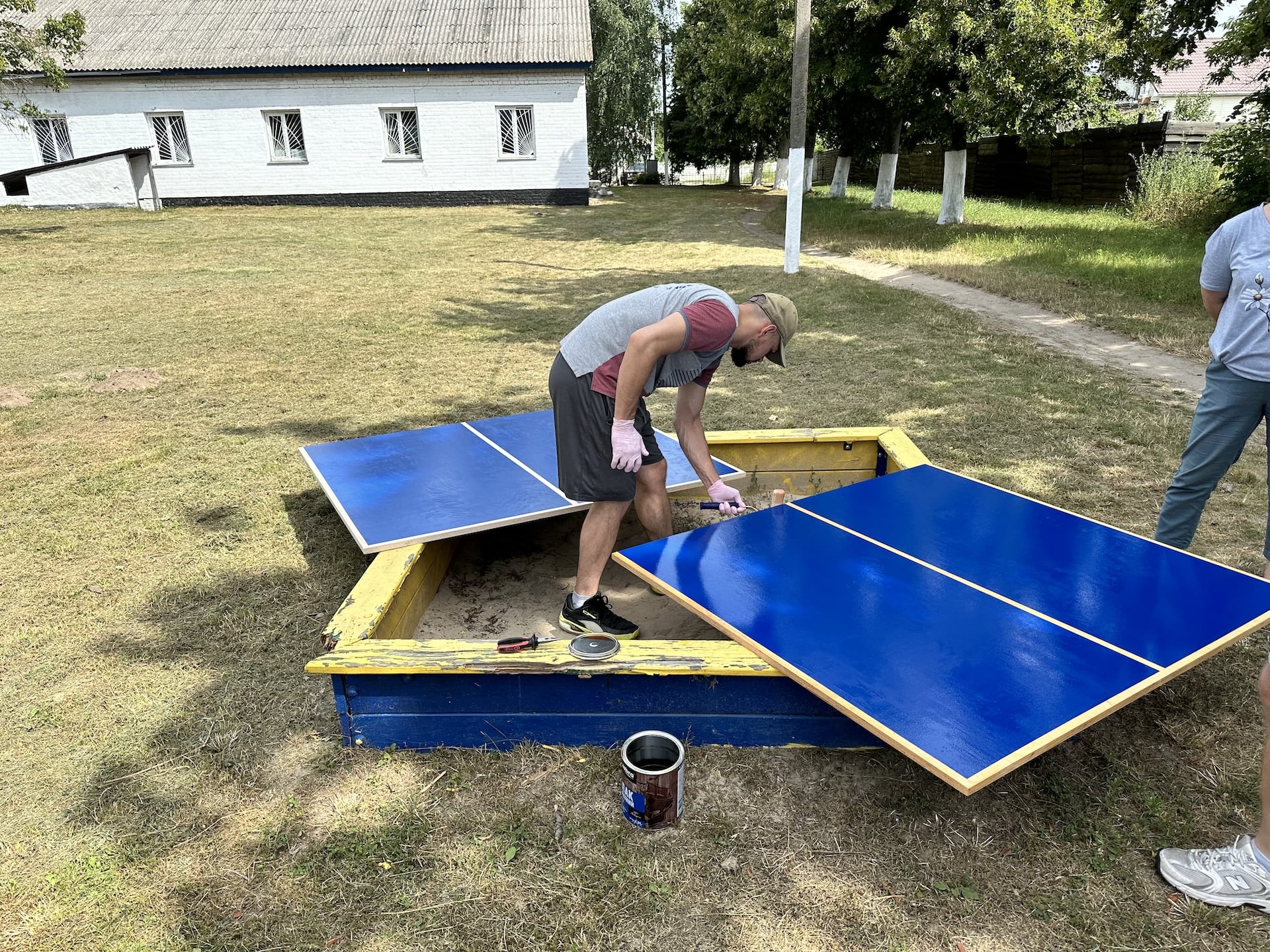
What tools did you use to strengthen social cohesion?
Social cohesion was one of our key priorities, as the community needed a space to rebuild trust and foster interactions among its members. We employed several approaches:
Interactive events – Discussions and workshops where participants not only listened to lectures but actively engaged with one another. This helped build connections and a shared sense of responsibility for the community’s future.
Collaborative restoration efforts – Residents participated in landscaping the area around the village club, which gave them a sense of involvement in positive change.
Support for informal communication – During events, we created a welcoming environment for informal conversations and knowledge exchange, strengthening social ties.
Did you notice any trauma among the people in the community due to the occupation? How did you address this?
Many residents remained under stress and experienced uncertainty about the future. Some avoided active participation, while others attended but chose to remain passive observers. We did not pressure them to engage but instead created an environment where they could participate at their own pace. Open communication, a lack of coercion, and opportunities to share personal experiences helped residents gradually become more involved in discussions.
Can you recall any powerful stories you heard during the project?
Each story we encountered was unique and deeply significant. The war left lasting scars on the lives of community members, and for many, recovery is not just about rebuilding structures but also about regaining emotional and psychological stability. Some residents are still struggling to process the trauma of war—some lost loved ones, while others returned to a reality that was completely different from what they had left behind.
What aspects were included in the process of environmental sustainability?
Environmental aspects are critical to recovery, especially in rural communities where people are directly dependent on natural resources. We sought not only to physically rebuild the community, but also to lay the foundation for its sustainable development. The use of sustainable materials such as wood not only contributes to the restoration of infrastructure, but also helps to develop new economic opportunities.
Why did you choose a workshop on the ecological use of wood?
We selected this topic for several reasons. First, wood is a readily available material in the region and can be used for construction and small business initiatives. Second, woodworking is a practical skill that can be applied to building restoration, furniture making, and other infrastructure projects. Additionally, this workshop allowed us to merge ecological and economic approaches, demonstrating how local resources can be utilized sustainably for the benefit of the community.
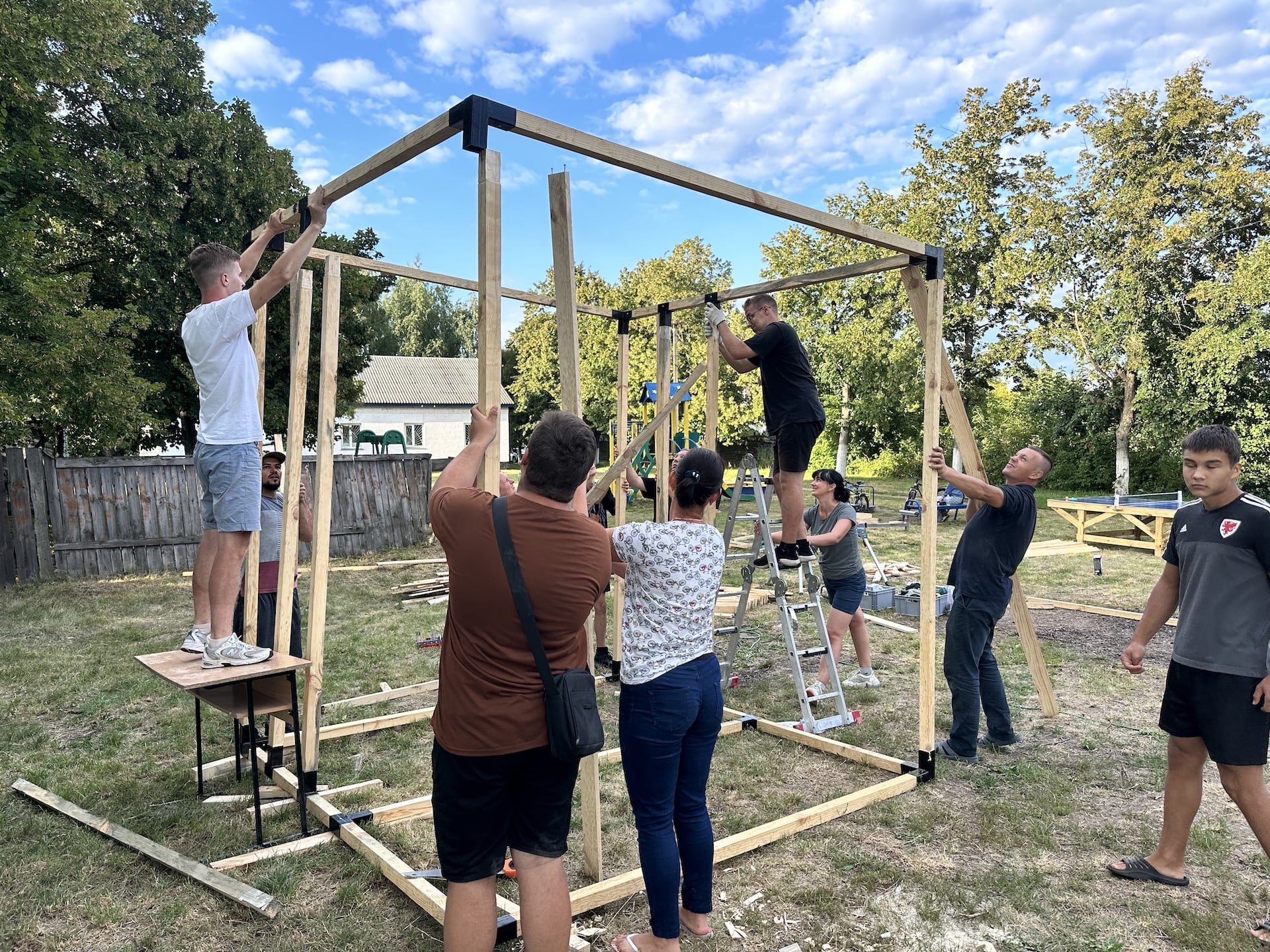
Why did you decide to include an environmental component in the project?
We included an environmental component in the project because we believe that community reconstruction should not only be fast, but also sustainable and responsible.
During the war, many natural resources were destroyed or used without regard to the long-term consequences, so it was important to integrate environmentally friendly practices into the recovery process.
In addition, the sustainable use of local materials such as wood opens up new economic opportunities for the community. We wanted to show the residents that eco-friendly solutions can not only be good for the environment, but also have practical value for recovery and economic development.
What were the biggest challenges you faced during the preparation and implementation of the project?
The main challenges included:
Security risks and mobilization restrictions, which led to event rescheduling.
Logistical difficulties, as some experts faced challenges traveling to the community due to martial law.
Fraud during timber procurement, where we encountered unscrupulous sellers but managed to recover our funds.
Did you encounter any administrative obstacles?
Yes, there were some administrative difficulties. The biggest challenge was the new legislation on mobilisation, which complicated the logistics and mobility of the team and invited experts. Some of our team members and partners faced problems travelling from Kyiv to the Chernihiv region. There were also some bureaucratic issues related to the approval of events, especially given the security restrictions. Nevertheless, we were able to adapt to the situation and reformat the schedule of events to minimise delays and ensure that all planned activities were implemented.
Could you outline the timeline of the entire project, from its official start to completion?
The official preparation of the project began in April 2024. We conducted research, communicated with local residents, prepared materials and coordinated all organisational issues.
The main events took place in the summer of 2024. Initially, due to a missile attack on Chernihiv, we were forced to postpone the original dates of the events. Later, there were difficulties due to mobilisation, but despite this, we managed to successfully implement all the planned activities.
The final wrap-up event of the project took place in August 2024, where we presented the results of our work, discussed the next steps and received feedback from the community.
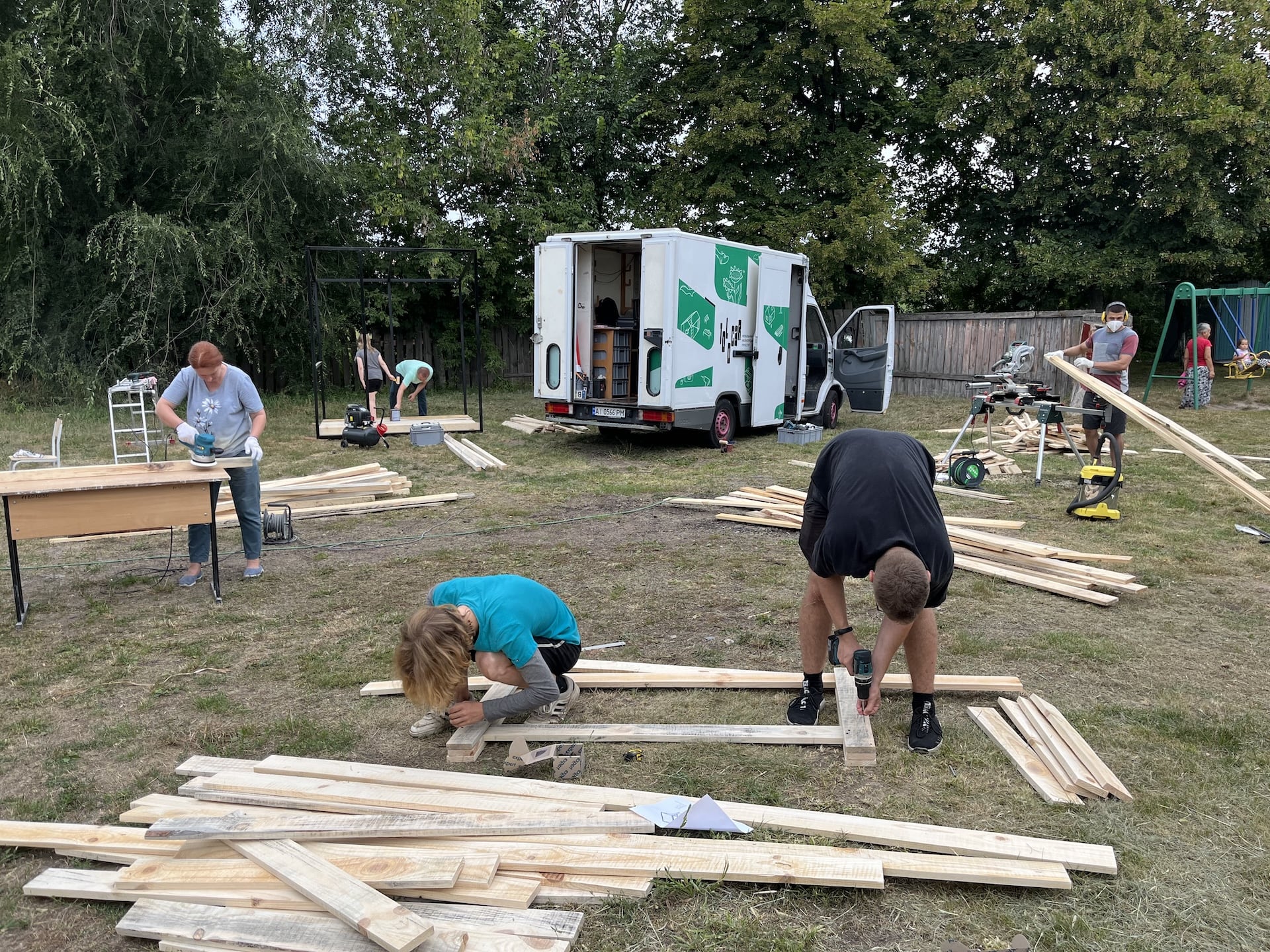
Let’s return to the community you worked with. How did they react? Did you encounter any resistance from them?
The majority of residents were positive about the initiative, but we observed some passivity in engaging in the events.
Before the event, we conducted a survey that showed a significant interest in the topic of reconstruction, but fewer people came to the events than expected.
This may have been due to the emotional exhaustion of the community after the occupation or to the fact that people have not yet felt their own influence on the reconstruction process. We did not encounter direct resistance, but some caution in the perception of the initiative was noticeable.
How were local residents involved in the recovery process?
The main approach of our project was not only to provide resources, but also to involve the community in the decision-making process. We organised discussions and workshops where residents could express their ideas for the development of the area. Also, some local residents joined in the arrangement of a public space near the village club, which gave them a sense of participation in real change. However, this process requires further support and motivation to engage the community more actively.
What were the expectations of the local people? And how satisfied were they afterward?
The expectations of the residents were quite different. Part of the community hoped for more practical results - physical restoration of facilities, jobs, and new opportunities for small business development. The other part perceived the project as an opportunity to gain new knowledge and join the process of change.
Feedback after the events was generally positive. People noted that they had received new information that they had not been able to hear before, and also appreciated the workshops and the opportunity to participate in the creation of public space.
Was there a moment during the project when you had to reconsider your goals?
Yes, we revised some of our goals when we saw that we had the opportunity to do more than we had planned. Thanks to the budget savings on per diems, we decided not only to carry out the planned activities, but also to implement additional initiatives, such as developing a concept for the interior and exterior of the village club and creating outdoor furniture.
This decision came after talking to the residents, when we realised that we had the time and resources to leave a more tangible mark on the community.
What tangible outcomes can the public see after the project’s completion?
After the project was completed, the community saw several tangible changes:
● The area near the village club was landscaped with new outdoor furniture - benches and a tennis table.
● A concept for the interior and exterior of the club was developed, which can be used for further renovation projects.
● Workshops and educational events were held to provide local residents with new knowledge and skills.
● The community gained more information about environmentally sustainable recovery approaches and small business opportunities.
How do you measure the success of the project?
We evaluated success based on several criteria:
Community involvement – While attendance was lower than expected, those who participated were actively engaged and provided positive feedback.
Project outcomes – We successfully implemented more initiatives than originally planned.
Media impact – Coverage by Suspilne Chernihiv helped amplify the project’s reach.
Long-term impact – The village club’s development concept can serve as a foundation for future projects, and the knowledge gained by residents can contribute to ongoing community growth.
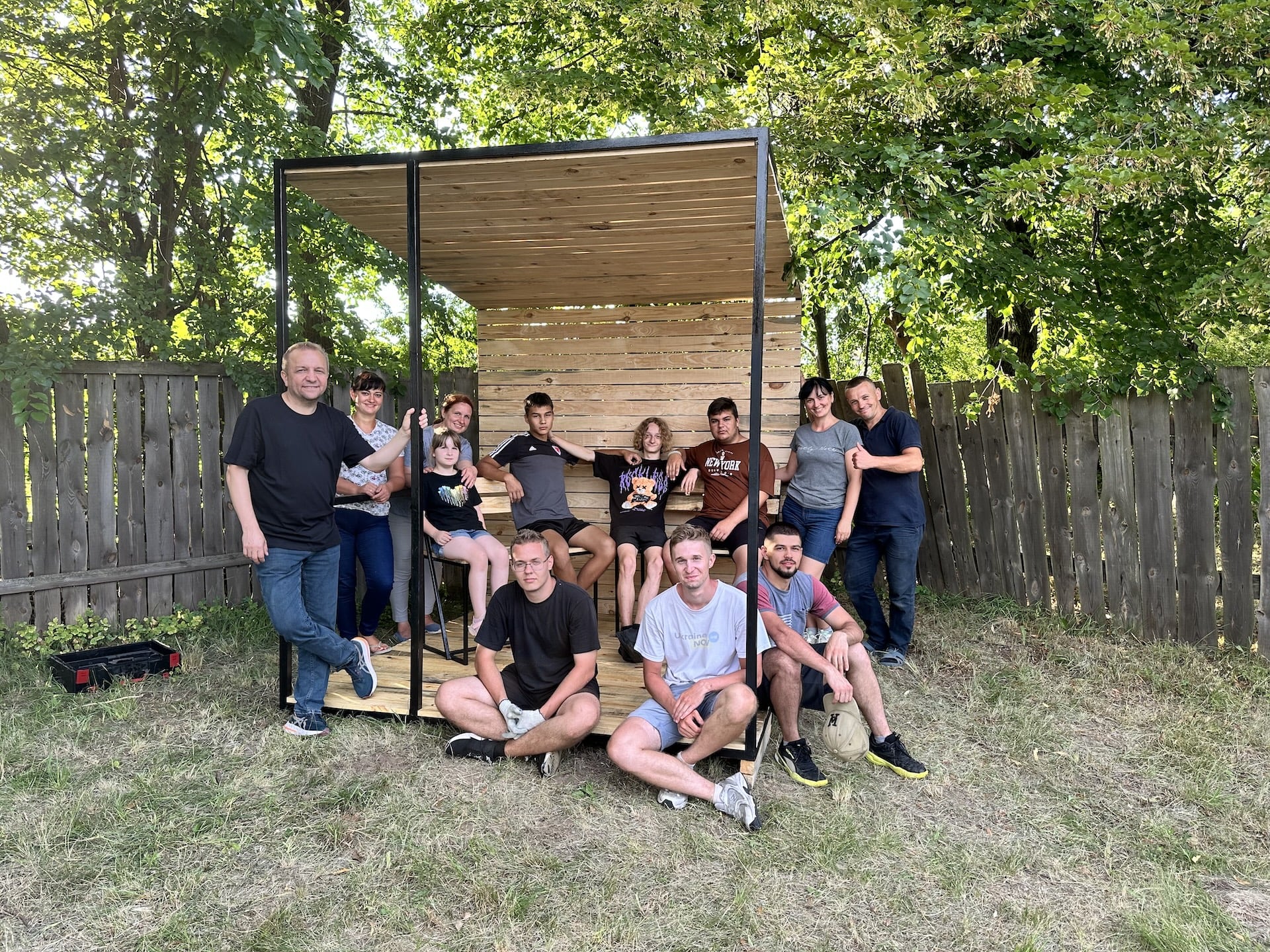
What will happen to the restoration efforts after the project ends? Do you have a plan for its long-term sustainability?
We do not see the project as a one-off initiative. One of our priorities is to find partners who can support the further implementation of the proposed ideas. We also plan to help the community find funding to implement the developed concept of the village club's interior.
In addition, the knowledge gained by the residents can be applied to other initiatives, and the club itself can become a platform for future educational and community events.
Could you introduce the individuals or organizations that collaborated on the project in more detail?
The project was implemented by the team of the NGO ‘’Thmist‘’, which includes experts in various fields - communication, architecture, urban planning, and public policy.
In addition, we engaged local activists to help organise events and experts in ecological construction and public space restoration. Media partners also played an important role, including Suspilne Chernihiv, who covered our events.
This project has shown that even a small initiative can give a big boost to future changes in the community if the right people are involved.
Author: Ján Janočko
ZMINA: Rebuilding is a project co-funded by the EU Creative Europe Programme under a dedicated call for proposals to support Ukrainian displaced people and the Ukrainian Cultural and Creative Sectors. The project is a cooperation between IZOLYATSIA (UA), Trans Europe Halles (SE) and Malý Berlín (SK).